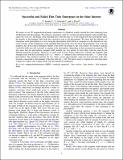Files in this item
Successful and failed flux tube emergence in the solar interior
Item metadata
| dc.contributor.author | Syntelis, P. | |
| dc.contributor.author | Archontis, V. | |
| dc.contributor.author | Hood, A. | |
| dc.date.accessioned | 2019-04-02T12:30:04Z | |
| dc.date.available | 2019-04-02T12:30:04Z | |
| dc.date.issued | 2019-03-18 | |
| dc.identifier | 258431534 | |
| dc.identifier | 4317577b-3913-418f-8376-8a283dc62b76 | |
| dc.identifier | 85064467443 | |
| dc.identifier | 000461631600002 | |
| dc.identifier.citation | Syntelis , P , Archontis , V & Hood , A 2019 , ' Successful and failed flux tube emergence in the solar interior ' , Astrophysical Journal , vol. 874 , no. 1 , 15 . https://doi.org/10.3847/1538-4357/ab0959 | en |
| dc.identifier.issn | 1538-4357 | |
| dc.identifier.other | RIS: urn:0BDA6FFE491C728DA39AEFDD8A673A66 | |
| dc.identifier.other | ORCID: /0000-0003-2620-2068/work/58055219 | |
| dc.identifier.other | ORCID: /0000-0002-6926-8676/work/73700878 | |
| dc.identifier.other | ORCID: /0000-0002-6377-0243/work/77131789 | |
| dc.identifier.uri | https://hdl.handle.net/10023/17418 | |
| dc.description | This project has received funding from the Science and Technology Facilities Council (UK) through the consolidated grant ST/N000609/1. The authors acknowledge support by the Royal Society. This work was supported by computational time granted from the Greek Research & Technology Network (GRNET) in the National HPC facility—ARIS. | en |
| dc.description.abstract | We report on our 3D magnetohydrodynamic simulations of cylindrical weakly twisted flux tubes emerging from 18 Mm below the photosphere. We perform a parametric study by varying the initial magnetic field strength (B 0), radius (R), twist (α), and length of the emerging part of the flux tube (λ) to investigate how these parameters affect the transfer of the magnetic field from the convection zone to the photosphere. We show that the efficiency of emergence at the photosphere (i.e., how strong the photospheric field will be in comparison to B 0) depends not only on B 0, but also on the morphology of the emerging field and on the twist. We show that parameters such as B 0 and magnetic flux alone cannot determine whether a flux tube will emerge to the solar surface. For instance, high-B 0 (weak-B 0) fields may fail (succeed) to emerge at the photosphere, depending on their geometrical properties. We also show that the photospheric magnetic field strength can vary greatly for flux tubes with the same B 0 but different geometric properties. Moreover, in some cases we have found scaling laws, whereby the magnetic field strength scales with the local density as B ∝ ρ κ , where κ ≈ 1 deeper in the convection zone and κ < 1 close to the photosphere. The transition between the two values occurs approximately when the local pressure scale (H p ) becomes comparable to the diameter of the flux tube (H p ≈ 2R). We derive forms to explain how and when these scaling laws appear and compare them with the numerical simulations. | |
| dc.format.extent | 17 | |
| dc.format.extent | 1521599 | |
| dc.language.iso | eng | |
| dc.relation.ispartof | Astrophysical Journal | en |
| dc.subject | Magnetohydrodynamics (MHD) | en |
| dc.subject | Methods: Numerical | en |
| dc.subject | Sun: activity | en |
| dc.subject | Sun: interior | en |
| dc.subject | Sun: magnetic fields | en |
| dc.subject | QB Astronomy | en |
| dc.subject | NDAS | en |
| dc.subject.lcc | QB | en |
| dc.title | Successful and failed flux tube emergence in the solar interior | en |
| dc.type | Journal article | en |
| dc.contributor.sponsor | Science & Technology Facilities Council | en |
| dc.contributor.institution | University of St Andrews. Applied Mathematics | en |
| dc.identifier.doi | 10.3847/1538-4357/ab0959 | |
| dc.description.status | Peer reviewed | en |
| dc.identifier.url | https://arxiv.org/abs/1902.07969 | en |
| dc.identifier.grantnumber | ST/N000609/1 | en |
This item appears in the following Collection(s)
Items in the St Andrews Research Repository are protected by copyright, with all rights reserved, unless otherwise indicated.

